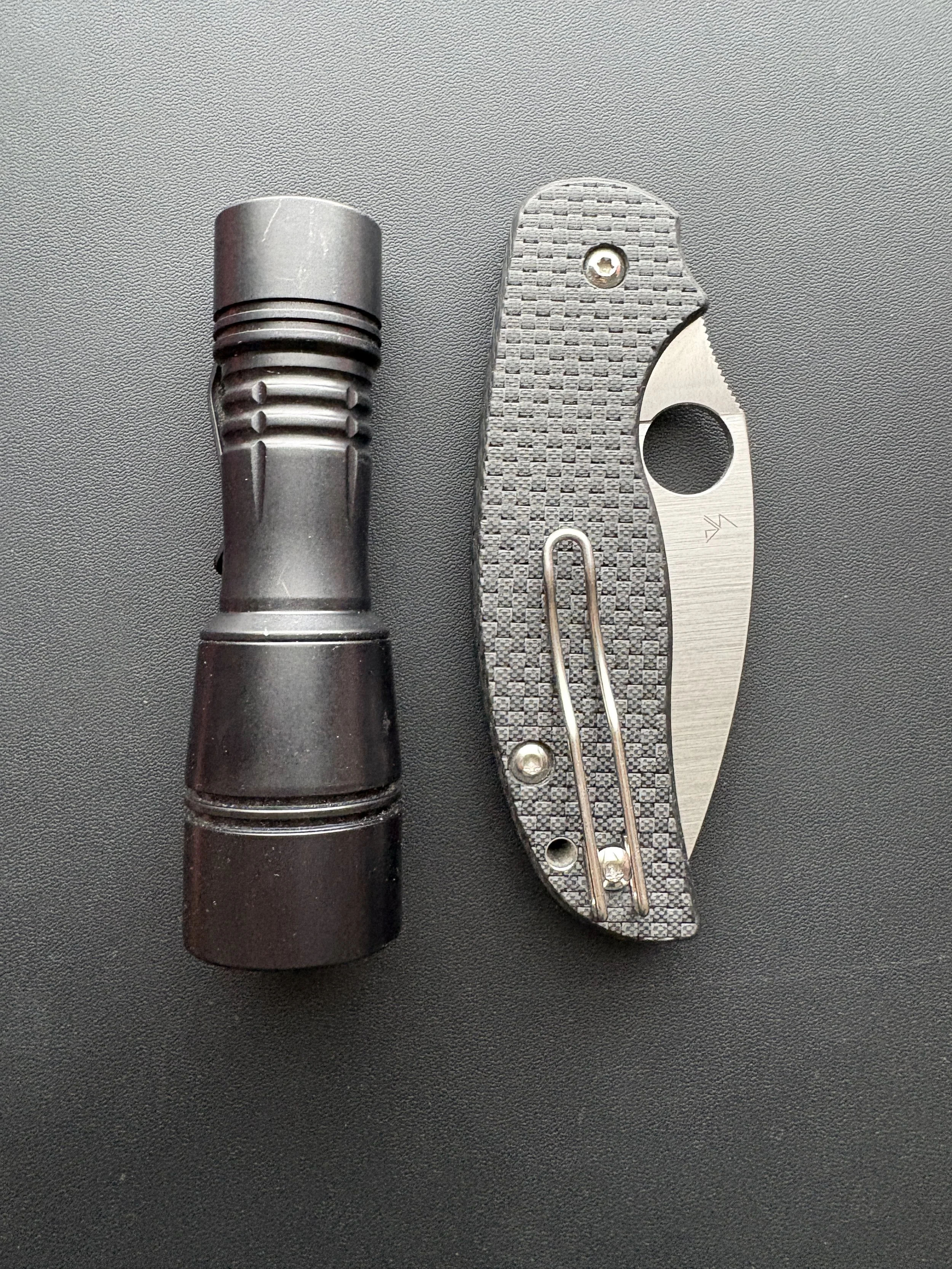Gear of the Year 2025
A quick note before we get to the post. These are pretty tough times for the gear business. People are making great stuff in every part of the market, but looking at things I can’t shake the sense that we are at a precipice. Tariffs are a huge issue, of course, but the market wasn’t healthy before them. They just might be the last straw before a shake up.
Competition from China has not just been strong, it has crushed the US companies. Let’s look at one discrete example—the Spyderco Button Up, a new “budget” release this year that costs $75. It sports 8Cr13MoV. How is this possible in 2025? 8Cr isn’t a bad steel, but it is certainly not a good one. I can’t think of a worse steel used by major brands, except for the really cheap stuff from Gerber and SOG that uses its even worse brothers (7 or even 5Cr).
The Button Up is emblematic of the problem that makes me worried for the gear market. The new companies—We/Civivi/Sencut and Vosteed chief among them—are doing laps around their American counterparts. Benchmade’s prices have gone back to their historical high norms, ZT’s line up has stalled again, and Spyderco is releasing an $80 button lock with 8Cr steel. This knife, done by Civivi or Vosteed would have 14C28N steel and cost $58. That’s not a problem, that’s capitalism. The problem comes when you look at what results from this flurry of competition. American makers end up behind the curve, overpriced, understeeled, and fighting last war’s battles on designs and materials. They end up looking very unappealing. On the other end the Chinese companies flood the market. With no one buying high end and no one interested in more mid market, there is no new way to stoke the fires of knife sales. I don’t think we are there yet, but we are getting there.
2024 was an unprecedentedly good year. This year has been not a down year per se, but a quieter one for sure. A lot of the stuff that is on this list is an upgrade or an iteration on a previously produced item. And dark times are ahead. The stock market is propping up the American economy while inflation eats away at things. If the stock market falters, the ripple effects will be huge. But if it doesn’t falter the gap between the market and reality will only increase. It is the Faustian bargain we have been making for the last forty years and eventually the income inequality chickens will come home to roost and when they do the disposable income that feeds the gear market will dry up.
On that pleasant note, let’s get to the awards.
Overall Gear of the Year: TIE Spyderco Sage 6 in S90V and Kosen x Malkoff VME
I hate when reviewers say things are a tie. Its just an excuse to avoid critically thinking about things. But this, this is a genuine tie. I generally start the Gear of the Year Article in September. This gives me plenty of time to think about good stuff and see what’s coming out. The VME came out in May or June and I reviewed it in June. It was, by a large margin, my favorite piece of kit I have reviewed in years. I am a flashlight guy at heart, only coming to the knife thing incidentally, so its not surprising I would like a light a lot, but this light is so good, so anti-gizmo, and so purely enthusiast that I can’t help it. Its gear like this that got me into the hobby and gear like this that keeps me writing fifteen years later. It would win by a large margin in almost any other year, even last year’s packed field. But the Sage 6 is such a perfect distillation of all that is great about Spyderco, that it is really hard to ignore. And since it came out around the time I started writing this, it was more front of mind. But then someone sent me an email and asked me what my favorite gear of all time was and I started thinking wistfully about the VME. Its just so good. But so is the Sage 6. And while I love lots and lots of different knives, I have always had a fondness for Spyderco designs. They are incredible and this is the apotheosis of all that Spyderco has done in its entire history. If this were a vignette for a sports championship, I would say “It all comes down to this.” This is all a long way of me saying this is not a cop out, but a genuine dilemma. Both are tremendous pieces of kit that you could be happy with for the rest of your life. And both came out in 2025. So its a fucking tie. Both with getting write ups.
Spyderco Sage 6 in S90V (Purchase)
Its hard to imagine how many knives it took to get to the point that we get the Sage 6. There are dozens of iterations—different handle shapes and sizes, different locks, different steels, different pocket clips, and different handle materials. But all of that variety poured into the Sage 6 in S90V and makes it the apotheosis of Spyderco, a sum of all the previous collective parts. And this knife is not just a sampling of Spyderco’s history, but a distillation of that history into a perfect knife. It does everything exceptionally well. Its slicey. It carries easy. It opens quickly. It locks solidly. Over and over again, the Sage 6 in S90V has proven to be the very best folder around. It is the only knife that is a perfect peer to the TRM N2. They are both so slim and functional that choosing between the two regularly converts me into Buridan’s donkey in the morning. Its taken years to get here, but this knife is amazing in every single way.
Carrot was one of the original guys on EDCF, the forum I started out in when I first got into gear. I was always impressed by his meticulous selection of things and how anti-trend his stuff was. He never got something because it was new or cool looking. It was all so considered and thoughtful. Like Parisians rejecting fast fashion, Carrot rejected the gotta catch’ em all impulse. And the thing was, every time I followed one of his recommendations I wasn’t just pleased, I was struck by how clearly correct his reasons for buying something were. Mostly I was obsessed with his notions about what made a good flashlight. This was peak Lumens Fever for me, and I slowly realized just how dumb that perspective was, largely because I followed Carrot’s recs and purchases with great fidelity. So when I saw that he had teamed up with Eugene Malkoff to make a light I was really excited. The VME is the the distillation of all those insights in one torch. Its color rendering is incredible, the size is perfect, and the UI is dead simple. You won’t find a better torch anywhere and only a small handful are its equal.
HM: Exceed Design Co Rampant, Leatherman Wave Alpha
As both HMs are entries, below, I will hold comments in reserve other than to say, the very best stuff this year was really good. In 2024, the really good stuff was like 12 or 15 items, not four.
Best Value: Vosteed Psyop 299 (Purchase)
What a beautiful knife. There are a lot of Geoff Blauvelt designs that have caught my fancy over the years, but none were as practical as this one. It is a remarkable blend lines and materials. Virtually all of them were beautiful and the action was great. This is my first “top liner lock” which is really a button-activated compression lock, and it is good. The strange thing was the price—$135. This is a $300 knife for less than half the price.
HM: Vero Avid, Ozark Trail Tanto
I didn’t like the Avid all that much, but a lot of folks did. It wasn’t poorly made, just not my thing and sorta a weird midrange knife. The Tanto, also not my thing (because of the blade shape) is really, really good. Much better than the D2 blade last year and only $10 more. If Wal Mart goes full tilt, the economic issues written about above will be the least of our worries.
Most Innovative: Exceed Design Co. Rampant (Purchase)
This is the new king of the hill light system now that the BOSS series is out of production and decades after Surefire gave up the ghost on Lego lights. It is a turnkey system that you can customize to basically any set up you like. But the real star is the UI. With the ramping rocker switch nothing is easier in the flashlight world other than use than the Rampant. It’s the rare combination of state of the art performance and mass market ease of use. If you don’t own one you really should.
HM: CRKT x Caswell Provoke Tomahawk, Swiss Mods Knipex Sheath 2.0
I haven’t had enough time with my Swiss Mods Sheath, but in terms of creating a new product class, that’s pretty impressive. And the T-Hawk, come on, that thing is cool and solves a longstanding problem with hatchets in the sweetest and most Caswell fashion ever.
Best Thing I Previously Missed: Lumintop Tool AA v3 (Purchase)
The Tool AA v3 is that rare item that pleases both enthusiasts and muggles alike. It is simple, easy to use, powerful, and small enough to carry with you everyday. There is nary a bad thing to write about this guy, especially because it is only $28. If everyone in the world could benefit from carrying a Swiss Army Knife, they could also benefit from carrying one of these. The use of RGBs in the tailcap means that Lumintop solved the “how do I find this problem” without resorting to epoxy and tiny vials of stuff that, according to the Internet, are radioactive but not too bad. This is the same Internet that brought us brilliant insights in the medicine, finance, and politics that makes 2025 a pretty shitty time to be alive. Its not to say that it is the Internet’s fault, but, instead to point out that the claim about the radioactivity might not be trustworthy. How that that tangent end up here? There is nothing more to say about the Tool AA v3 other than it is great.
HM: Benchmade Mini Bugout in S90V, Zebralight SC65
There is always stuff you miss and these two are just instant classics. The SC65 is the light that made the 18650 battery format compelling. Before it resulted in lights that were too big without enough performance over an 18350. And the MBO is just awesome.
Best Knife: Case Crossroads Barlow
The Tony Bose collabs were PEAK Case—a perfect marriage of collaborators. But since then Case has been pretty much dead to enthusiasts that aren’t Case collectors. Even their modern traditional knives were a surprising swing and miss. But the Crossroads series brings them back to the spotlight. The Barlow is particularly tasty with either Richlite or Micarta. They also incredibly light AND they sport modern PM steel (S35VN, one of my favorites; see Psyop 299 above).
HM: Tactile Knife Co Rockwall v2, AG Russell Gent’s Knife, Victorinox Refined Onefold
The choice to go bigger with the v2 Rockwall is why I haven’t reviewed it yet, but the knife still looks great. The rebirth of the Gent’s Knife, now with Elmax, is wonderful. If you still haven’t snagged a true pocket knife yet, try it. Your grandpa got by with nothing more for decades. And the Onefold, is it good? Is it bad? I still don’t know, but I like carrying it and using it. Its going to take a while think through all the changes to a classic format.
Best Light: oLight Turbo Baton (Purchase)
Go check, Hell may be festooned with icicles. Yes, I hate the Baton. And yes, I think I am the only person. So all you folks with your Para3/Baton4 EDCs, feel free to hate me—you are carrying pocket trash with pinchy handles and pukey tints. I had all but given up on oLight but them the Turbo version came out and you know what? It’s pretty good. Like with the 47s Mini, it’s the Turbo head that has the secret sauce. I am also very pleasantly surprised at how useful the LED display is around the e-switch.
HM: Acebeam Tac 2AA, Emisar D3AATi, Streamlight ProTac HL-X
Like with most 18650 lights, I don’t find the 2xAA format compelling, but this one is close. I also have not tried one of Hank’s builds in a while but this one is tempting. The new Streamlight is slowly, ever so slowly inching them towards modern light performance. They will get there eventually, but when they still have all that sweet LEO money coming in, innovation isn’t their top priority.
Best of the Rest: Leatherman Wave Alpha (Purchase)
With G10 handles in multiple color ways and some really great tools including a Magnacut main blade, the Wave Alpha is perfectly designed for the enthusiast market. The Arc is the tool for the guy that has a King Ranch Ford F-150 and just buys the most expensive thing. The Wave is for the hardcore EDC fan that loves the Wave (which is great, but not as great as the Skeletool CX—fight me).
HM: Tactile Turn Switch Pen, Spoke Designs Clickstream, Victorinox Synergy X Alox
The first all new mechanism from Will looks promising, but my pen needs have really slowed down with the advent of my Remarkable 2. The same is why I haven’t tried the Clickstream. Both look great, I just can’t justify the purchase.
Manufacturer: Vosteed
Vosteed released five or six really good knives this year. They seem to have struck a balance between the quantity of Civivi but the quality of Spyderco. The Psyop 299 was a surprise and an amazing knife. The Marten, the Corgi V, the Psyops, Parallel, and the Porcupine are all outstanding designs. Many of them debuted or were refined in 2025. That line up is pretty incredible for a single year.
HM: Jack Wolf Knives, Kansept, Ferramonster
All four of these companies have released interesting stuff this year. Kansept makes a banger of a knife—affordable and flawlessly built. Jack Wolf has started in on the modern market and the stuff is good, but not quite what I typically carry. If they drop a flipper with a 2.75-3 inch blade, I am in. And Ferramonster’s stuff all seems at least good. Note that all four companies make their knives overseas.
Best Community Member: Todd Parker
Todd’s channel isn’t squarely an EDC channel, but he is really great at presenting information. His thoughtful approach to organizing and grouping tools together really helped me organize my workshop and my homemade tool box. So far, great foundation. But then things got interesting this year when he started making stuff through his Esty store called Swiss Mods. The first thing he made was a precision driver scale tool for SAKs. His video on that is found here. But it was the next thing that, in my mind, stands to really impact the EDC community—his Knipex Pliers sheath. Thanks to very careful designing and precise printing he has developed a holster for the Cobras that also has a rachet/microdriver and scale tools. The entire set up is a perfect complement to a folder, creating a much higher quality and lighter multitool than, say, a Leatherman Wave. It sold out in 2.5 hours in the beginning of October. He released a 2.0 version, which is on its way for review. If this is the start of something, given these three items and Todd’s great channel, I can’t wait to see what’s next. There are a lot of cottage or niche creators out there. Some make weird stuff. Some make decent stuff. Todd’s items are top shelf. Let’s hope there is more coming, specifically something with a flashlight (may I recommend the Acebeam Keylite—it’s the perfect size, shape, and brightness).
Best YouTube Channel: Outdoor Boys
Yes, they won before. And yes, they technically went dark in 2025. But Luke promised three videos be released before the end of the year and he delivered. Not only that, they were the three best he has released in years. They are each among the best videos on his channel or any Youtube channel. If they don’t inspire you to get outside or work on projects, I am not sure what will. Someone needs to volunteer to do all of the non-adventure stuff for him. The world is better with Luke videos. And, get ready, the walrus video is incredible.
Just the Worst: Wuben G5
I have given out exactly two zeros in my entire fifteen plus years of doing this and none have been more meritorious than this one. This is an atrocious trainwreck of a design, a collection of marketing department bullet points with not a single idea of how to make something that humans want to use or even can use. Here is a pro-tip: search for “Wuben G5 reviews” on Youtube. Scan the thumb nails. If anyone recommended this light, just avoid them. While everyone is entitled to an opinion, some of them are as commonsensical as lead life jackets.
Amazon Links
Benchmade Mini Bugout in S90V and CF






